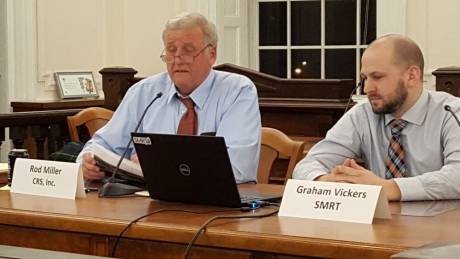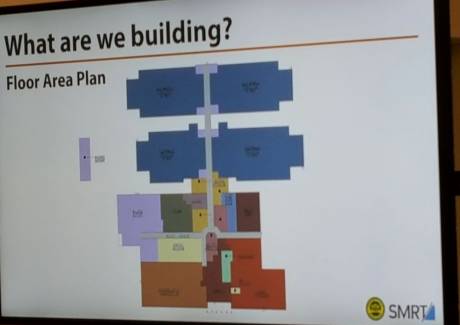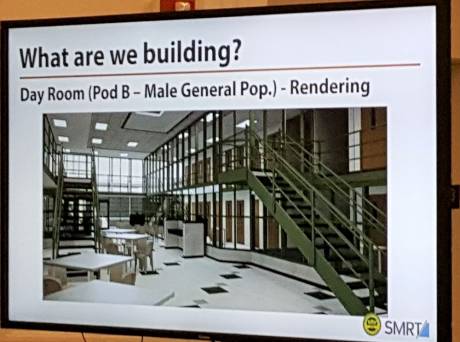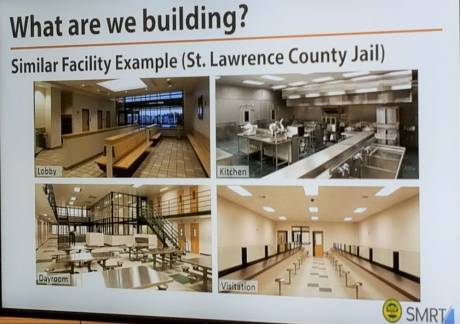
While acknowledging a high degree of uncertainty brought about by New York’s new bail reform laws, Genesee County officials – working hand-in-hand with consultants, engineers and architects experienced in correction facilities – are moving ahead with their plan to build a state-mandated 184-bed jail on property just east of County Building 2 on West Main Street Road.
“It’s the worst time in New York State history to be building a jail … but it must be built,” said Matt Landers, assistant county manager, referring to the state’s recently passed legislation that has eliminated cash bail for most misdemeanor and nonviolent felony offenses, thus reducing the number of those charged with a crime who are remanded to jail.
Landers, cochair of the jail committee along with Sheriff William Sheron, was speaking at tonight’s public information session at the Old County Courthouse about the proposed $60 million project.
Approximately 40 people, including county legislators, jail committee members and interested citizens, attended.
Landers and Rod Miller, president of CRS Inc. (Community Resource Services) of Gettysburg, Pa., a consulting firm that specializes in the correction and detention fields, agreed that the changes to how bail is applied have created a dilemma when it comes to projecting jail housing requirements.
Already, the new laws, which took effect on Jan. 1, have resulted in a downsizing of the new county jail from 214 beds (originally), then 200 beds – each with five pods – to 184 beds with four pods.
“They are the most extensive set of laws passed in the country,” Miller said, noting that California also is in the process of bail reform but not “as extensive” as New York’s. “We’re trying to anticipate the impact and that’s been very difficult. It’s kind of a crap shoot; there’s no question it will reduce jail population.”
Still, the county is obligated to replace its current jail at the corner of West Main Street and Porter Avenue.
Built in 1902 (with an addition/renovation in 1985), the jail is not conducive to effective supervision, has inadequate space for services and programs, and does not have the capacity to house female inmates – a situation that costs the county hundreds of thousands of dollars annually to transport these women to other jails, Miller explained.
“The current jail deficiencies are pretty well documented,” Miller said, adding that the county is liable no matter where inmates are housed and must abide by strict state Commission of Corrections standards that cover safety, security, separation, conditions of confinement, and medical and mental health care.
In reality, the COC is driving the bus, so to speak, toward the erection of a new jail.
“The COC decides how jails operate and the capacity of the facility,” Miller said. “They had to approve the number of beds.”
The COC also requires all cells to be single occupancy – “a big impact here on the design (and accompanying cost),” he said – and “direct supervision” management of inmates, again a safe but costly proposition.
“Costs increased 20 or more percent per square foot due to the strict requirements,” Miller said, “and that is borne by the county.”
Previously, Landers submitted a budget for the project that shows actual construction costs at $49.7 million. The price tag increases to $60 million when adding in design, furnishing, bonds and insurance, construction management, planning and development, and unexpected costs.
County officials said the jail will be funded by bonds that will be paid back by sales tax revenue that has been shifted away from towns and villages per a new state-approved sales tax agreement. They also said that jail construction will not result in a property tax hike.
Miller pointed to the contribution of the county’s Criminal Justice Advisory Council, which helped all parties in assessing future population trends and housing needs.
“We had access to their monthly meeting and had plenty of discussions,” he said. “CJAC represents all facets (of criminal justice and law enforcement) and is a model for other communities.”
Explaining that the “number of admissions does not correlate to the number of beds used,” Miller said that after three days, 47.9 percent of inmates have been released, after using only 1.6 percent of the total beds. Furthermore, 73 percent of all inmates are gone within 30 days, having used just 13 percent of the annual beds.
“The three days (data) is the target of the bail reform laws,” he said, “and it is very tough to figure out the impact of bail reform in the long term.”
He also emphasized that the new jail will have a specific area for “central arraignment” and processing – a cost-saving measure – and is likely to take in inmates who formerly might have been headed to state prisons.
Most importantly, Miller said, the new jail will provide sufficient female beds, house detainees who present substance abuse problems, and provide a secure treatment facility and acceptable short-term holding and separation.
He did mention the possibility of a regional jail, noting that there are 130 of these types of facilities in the United States, but said that although “they make a lot of sense in principle, it is hard to find a solution that works for all parties. It is not a viable solution right now.”
Following Miller’s presentation, Graham Vickers, principal/director of justice practice for SMRT, an architectural firm out of Portland, Maine, gave an overview of the site plan.
“We have been working with the (Genesee County) group since 2017 and are 50 percent through the design,” he said, adding that they’re shooting to break ground this September.
Vickers said the building will consist of a front portion for staffing and programming and a back section of four separate rectangular structures behind.
He termed a space dedicated for arraignments as a “unique feature” that will limit travel expense and security issues.
“The jail has an internally driven design … which considers those who work there and those who are detained (first),” he said.
He also noted that there will be “educational spaces” for religious or classroom teaching, with the day room built with a safety as a priority.
The day rooms are being built with an emphasis on safety, he said. Landers added that the dayrooms in each pod are designed in such a way that one corrections officer will be able to oversee up to 52 inmates, making them "much more efficient."
Landers said the new jail is being constructed with a life expectancy of 50 to 100 years. He applauded his committee for its hard work.
“We did our best to analyze the data and trends, believing that they will start emptying the state (prison) population into our jail,” he said. “We spent the last three years of analysis … without having a crystal ball (to decide what is) best for the future.”
At the end of the formal presentation, two Batavia residents offered their opinions and asked some questions.
Ron Greer, former Genesee County Jail superintendent, said “you’re going to have a hard sell (with the public),” directing his comments to county legislators.
He said that he hoped that the county could generate revenue right away – and not a year down the road – by housing females.
Still, he acknowledged the county has the responsibility of taking care of all who are sent to jail.
John Roach asked what the plan was for the current jail, suggesting that the city may be abandoning the building next door (the current City police headquarters) in the near future.
Landers said SMRT has been charged with providing possible solutions, but no decision has been made yet.
Roach also asked if the new building considered the disabled – it does meet Americans with Disabilities Act guidelines, Vickers said – and if juveniles would be kept there. Sheron replied juveniles would be housed somewhere else.
As far as double-bunking is concerned, Roach said, “they have that in Attica. It’s OK for them but not OK for you.”
It also was pointed out that the design’s infrastructure (such as heating/cooling and kitchen) is in place to handle the addition of two pods if necessary, and that the county will need to hire more corrections officers and support staff.



Photo at top -- Rod Miller and Graham Vickers; photos at bottom, various views of the proposed new county jail -- floor plan, dayroom and similar facility. Photos by Mike Pettinella.
